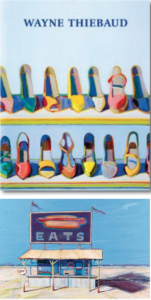
by John Wilmderding
Acquavella Galleries
www.acquavellagalleries.com
Rizolli International Publications
www.rizzoliusa.com
“In a career of almost unparalleled longevity and qualitative consistency, he has gained a much-admired seniority among American realist painters. Known for his sensuous brushwork, strong saturated colors, and manipulated spatial design, he has produced an unmistakably singular body of images in an equally personal style of execution,” writes John Wilmerding in Wayne Thiebaud, a large-format book surveying the artist’s work from the 1960s up to his recent Hot Dog Stand, which he completed last year.
Barbara Pflaumer, editor of the forthcoming magazine Foreground: Fine Art for the Culturally Curious (coming from Shelf Media later this year), talked to the 92-year-old painter about painting, subject matter, and hotdogs.
Shelf Unbound: Hotdogs have been a subject you’re returned to over the years. You painted a row of them in 1961’s 5 Hotdogs and you’ve got one on a sign in last year’s Hot Dog Stand, which was on the cover of the New Yorker. What’s the appeal of this subject for you and what does it mean to you?
Wayne Thiebaud: Essentially it is a subject matter that offers a chance for painting in a different way, which generally has been the probe of my painting research. I am continually looking for things that have meant something to me. I worked in those kinds of stands when growing up as a young boy and I draw and paint them from memory. It is a sentimental journey in some ways and represents a wider reference to American culture and experience in the way people work, eat, dress and the places they like to go and are in the habit of going to as part of their daily lives.
Shelf: Does photography have a role in your process?
Thiebaud: No. I do all my work by memory and drawings.
Shelf: Does irony or whimsy play a role in your work?
Thiebaud: I am less interested in that and more in the positive challenges that represent traditions of paintings and the notion of caricature. As an old teacher, the concept of caricature is central to the notion of style. People don’t invest the time of knowing what role caricature plays in the character of space, color and light—but it is important to examine those things which are central to the act of painting and essential to use in the character of light. How one can use many kinds of light in a single painting—the glint of light, the focus and out of focus use of light —that’s what Vermeer did and what gives his paintings magic, the magic of caricature. Bonnard caricatures everything in his paintings, his space is almost nutty—he gives his space uniqueness and personal style. These artists have developed a new vision species—also Van Gogh and De Kooning—other worlds they have created that are parallel and unique.
Shelf: You are perhaps best known for your paintings of desserts—colorful rows of cakes, or ice cream cones, or lollipops. Does that subject still interest you?
Thiebaud: I still paint that subject matter—I approach each painting with a slightly different problem with the light and the space of the works and I like to take it on again. A painting from 1950 and what you do with it today fascinates me—I encourage my students to do the same as Cezanne proved there is no such thing as a finished painting, there are only completed works.
Shelf: Do you have a sweet tooth?
Thiebaud:
Yes.
Shelf: We’ve got a dog theme going in this issue. Are you a dog
person?
Thiebaud: I’m a dog lover but no longer have a dog.
Shelf: Who is your favorite author and whom are you reading today?
Thiebaud: Flaubert’s Parrot and a lot of poetry—the life of the mind is as rich and as wide as we make it and is of primary importance to painters. If painters do not use art, history, and literature, which have always been linked, they are not very good painters.
